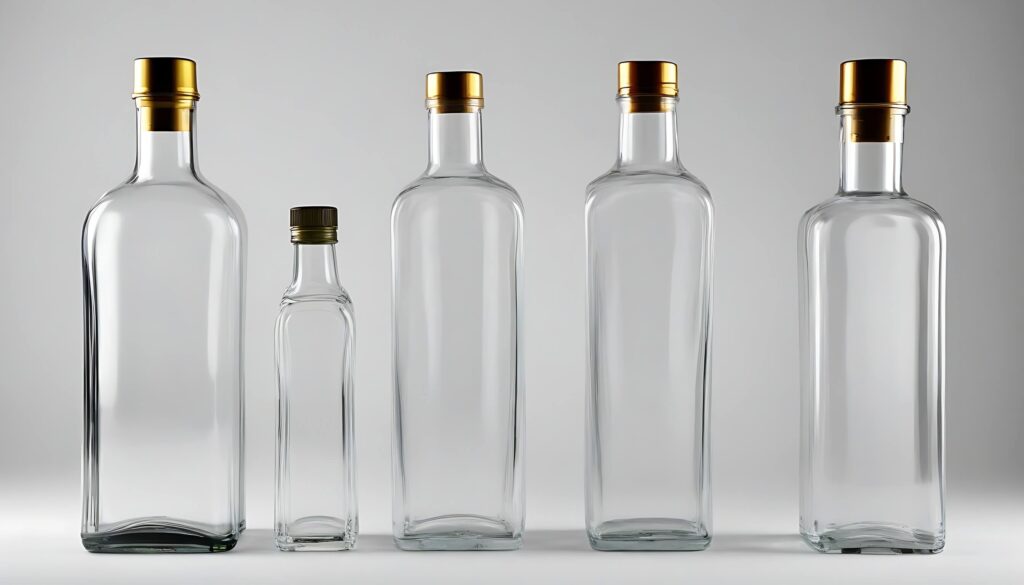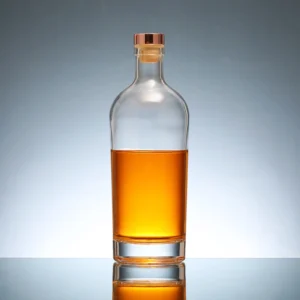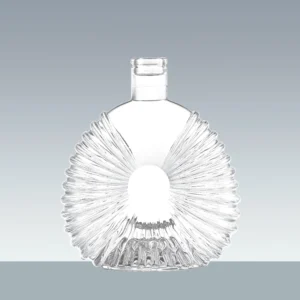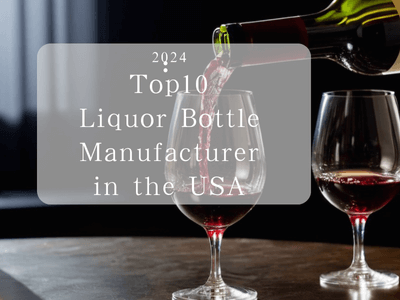Maten van whiskyflessen in de wereld! Het is inderdaad een fascinerend onderwerp. Whiskyflessen hebben verschillende...
Maten van drankflessen: Een complete gids
Welkom bij een gids over maten drankflessen. Whether you’re a bartender, own a liquor store, or just enjoy unwinding with a drink at the end of a long day, knowing your bottle sizes is pretty important.
From standard fifths to giant Rehoboams, there’s a surprisingly wide variety of likeurfles maten om aan verschillende behoeften te voldoen.
In this article, we’ll take a lighthearted yet informative tour through that magical world of liquor vessel volumes.
We’ll answer all the hard-hitting questions like how many shots are in the average bottle size and what the deal is with weird names like “Handle”
But first — before we get into the nitty-gritty details — let’s quickly go over why liquor bottle sizes even matter in the first place.
Inhoud
verbergen
Waarom de grootte van een fles belangrijk is
First things first – what difference does bottle size actually make for the average drinker or bar owner? Let me give you a few reasons:
Kennis van de standaardvolumes van drank helpt barmannen om shots en cocktails nauwkeurig in te schenken. Niemand houdt van gierig schenken! En geen enkele bar kan het zich veroorloven om drankjes uit te delen die te royaal zijn.

Inzicht in flesmaten maakt het ook makkelijker voor bars en slijterijen om de voorraadbehoefte in te schatten. Als je op een gemiddelde avond ongeveer 30 shots drinkt en vijfde flessen koopt, weet je dat je ongeveer twee flessen nodig hebt om de bar te bevoorraden.
Bij het plannen van evenementen geven flesgroottes hosts een beter idee van hoeveel drankjes ze kunnen verwachten. Als je 100 gasten op een bruiloft hebt, zijn vijf flessen wodka misschien een beetje overdreven!
And when you’re just having a casual drink yourself, the bottle size lets you know if you need to make a liquor store run anytime soon. No one wants to be left high and dry with an empty bottle on Friday night!
So while paying attention to liquor bottle sizes might not be the most glamorous knowledge in the world, it’s definitely useful info to have on hand as a professional or enthusiast. Knowing your volumes helps things run more smoothly all around!
Standaard en gangbare flesformaten voor drank
Alright, now that we know why liquor bottle sizes matter, let’s dive into the most common sizes and formats you’ll typically see. We’ll start with some of the standards almost everyone recognizes.
The Shot / Miniature – 50 ml
Coming in at a cute 50 ml, the miniature bottle or “mini” holds approximately one shot of liquor. These little guys are usually referred to as nips in the US and Scotland. You’ll often find minis sold in packs at the liquor store. They’re the perfect size to toss in your purse on a night out!
The Half Pint – 200 ml
Despite the name, a half pint bottle actually contains just 200 ml, which equals almost 7 ounces. With 4 shots worth of liquor, the half pint is a nice compromise between portability and value. It’s a popular format for higher end spirits like Cognac.
De pint / 375 ml
Again, the name is kind of a lie! A pint bottle holds 375 ml, which works out to 12.7 ounces. Even so, it’s still equal to about 8 shots – nothing to sneeze at. Mickey and flask sizes tend to come in the pint range.
De Vijfde / 750 ml
Here’s one name that’s actually accurate! As the most common liquor bottle size, “fifths” hold exactly one fifth of a gallon at 750 ml. That equals close to 25 ounces or 17 shots. When people refer to a “standard” liquor bottle, this is typically what they mean.
De Liter
A liter is exactly what is sounds like – 1000 ml of sweet, sweet booze. At almost 34 ounces, that works out to a generous 22 shots. Liters are less common than fifths in America but very typical for European spirits.
The Magnum – 1.5 L
Now we’re moving into grand territory! At an impressive 1.5 liters capacity, a magnum has 50 ounces of liquor within – good for about 34 shots. Due to the size, magnums are usually saved for special occasions and gifts…or hardcore party animals.
The Handle – 1.75 L
Referred to as a “handle” for the built-in handle at the neck, this size contains 1.75 liters (around 59 ounces). With nearly 40 shots worth of liquor, the handle is a economical choice for bars and liquor stores.
As you can see, liquor bottles come in an impressive range of sizes. Whether you’re looking for a single shot, stocking up for a wedding, or just want that mega novelty bottle to impress your friends, there’s a volume format out there to suit your needs.
Aantal shots per flesgrootte
Here’s a breakdown of approximate shot amounts per common bottle format – give or take a little pour generosity, of course.
The Miniature – 1 to 1.5 shots
Since the miniature bottle only holds 50 ml of liquor to start with, that works out to just a single shot…or maaaaybe a shot and a half if you’re being generous at the bar that night!
The Half Pint – 4 shots
Despite being pretty portable, the half pint bottle still packs a decent punch with 4 full-sized shot’s worth of liquor. Perfect to stick in your bag for pre-partying!
The Pint – 8 shots
Moving up to the pint, we’ve got capacity for a solid 8 shots now. Whether you’re sharing with friends or indulging in moderation, plenty of fun to be had here!
The Fifth – 17 shots
Here’s where we start entering serious party territory! The standard fifth size equates to approximately 17 hearty shot pours – definitely enough to get the good times flowing.
The Liter – 22 shots
If the fifth wasn’t quite enough, stepping up to the liter truly cements your hosting chops with 22 full shots inside. You’ll be everyone’s best friend if you show up toting one of these bad boys!
The Magnum – 34 shots
And the big guns have arrived! A magnum bottle comfortably holds over 34 shots, ensuring there’s plenty of revelry to go around. Of course with great liquor volume comes great responsibility.
The Handle – 39 shots
Last but not least in the common sizes, the handle practically overflows with almost 40 full shots inside at maximum capacity. Equipped with its own carrying handle, this mighty vessel is a bar’s best friend!
I think it’s pretty incredible how the standard bottle sizes scale up – all the way from a single mini shot on up to nearly 40 servings in the handle.
Unieke flesformaten voor drank buiten de standaarden
We hebben al veel van de gebruikelijke strategieën besproken die private labels gebruiken om op te vallen.
Maar er zijn ook nog exotische, unieke formaten die je kunt tegenkomen.
Om op te vallen zijn drankmerken soms heel creatief met hun flessen.
Enkele van de meer uitzonderlijke maten die afwijken van de norm zijn:
200 ml Retro-flessen
De 200 ml heupflacon gaat terug tot de drooglegging en roept beelden op van discreet zuipen en guitige figuren die aan de aandacht willen ontsnappen met een verborgen drankje.
3 L dubbele magnums
Think the 1.5 L magnum is impressive? A select few brands show off with double magnums weighing in at a substantial 3 full liters! That’s large enough to bathe in.
The Rehoboam – When a Magnum Just Isn’t Enough
Meet the Rehoboam, the granddaddy of alcohol bottles. It’s a colossal 4.5 liters or 152.2 ounces of liquid goodness, giving you over 101 shots of joy in 1.5-ounce servings.
Obviously, the Rehoboam bottle is total overkill for everyday drinking needs. You save this big boy for only the most monumental occasions – massive house parties, wild bachelor/bachelorette bashes, maybe New Years Eve if you really want to ring it in right!
En als je dan toch een Rehoboam opentrekt, kun je maar beter een leger paraat hebben staan om hem te helpen oppoetsen.
As you can see, even though standard fifths, handles and minis make up most sales, there’s no limit to the creative bottle sizes and shapes mixologists and marketers can dream up. Part of the fun with collecting fine liquor is discovering those unique specialty offerings!
Verschillende drankcategorieën
De wereld van sterke dranken kent een indrukwekkende diversiteit in culturen, waarbij elke drankcategorie zijn eigen productiemethoden, smaken en culturele betekenis heeft.
Laten we eens kijken naar enkele populaire categorieën en hun unieke kenmerken.
Whisky: I’m sure most are familiar with whiskey and its American sub-category, bourbon – both pillars of the spirits world renowned for rich, complex flavors. True bourbon originates from the US, particularly Kentucky, made primarily from corn and aged to perfection in charred new oak barrels. This specialized aging process gives bourbon its iconic deep amber hue and infuses flavors like caramel, vanilla and occasionally warming spice notes. Other broader styles of whiskey have their own production and flavor nuances, but share bourbon’s robust and multi-layered profile.
Wodka: In contrast, vodka often serves as a blank canvas for cocktails – valued for its crisp purity rather than bold flavor. High-quality vodkas are distilled to remove virtually all vestiges of taste or aroma, making them an excellent neutral base to let other ingredients shine. Traditional vodka can derive from various grains or even potatoes, each lending subtle character. But it is this quality of crystalline clarity that cements vodka’s versatility across cultures.
Rum: Then we have the entirely unique spirit of rum, a diverse range of offerings originating from sugarcane byproducts. Production methods, aging variations and regional styles contribute to the broad spectrum – from light and mildly flavored mixes to deeply complex sipping rums. While the Caribbean is renowned for premium rums, each island puts its own flair into the flavor profile through local aging and blending practices. Notes can range from tropical fruits and vanilla to rich molasses and caramel.
Tequila: Of course, we can’t discuss spirits without mentioning Mexico’s beloved tequila – a distinctive category made solely from the blue agave plant. Its most common styles of blanco and reposado offer vastly different experiences – blanco featuring vibrant, grassy agave while time in barrels lends reposado hints of oak, caramel and vanilla. And tequila holds a special cultural significance in Mexico, enjoyed neat or mixed intococktails like the iconic Margarita.
Gin: Then there’s the resurgent spirit of gin, flavored predominantly with juniper berries and other botanicals that create its aromatic, complex flavor. Gin producers carefully select botanical mixes that complement the juniper foundation with herbs, citrus, spices and more. Styles vary too, from the historical London Dry to contemporary New Westerns. This versatility makes gin a vital component across cocktail formats.
Likeuren: And finally, for those with a sweet tooth, liqueurs provide a tantalizing infusion of fruit, cream, herbs, chocolate and other indulgent flavors. Though lower in alcohol, liqueurs pack substantial taste into every smooth sip – whether enjoyed neat, on the rocks or mixed into after-dinner cocktails. There is seemingly no limit to the diversity, from floral elderflower types to the thick, velvety Irish Cream.
When it comes to storing and serving, not all bottles are created equal…
Regionale verschillen in drank
When we think of our preferred spirit – be it whiskey, vodka or gin – the bottle sizes seem standard enough. But notable diversity exists across global regions – from European metrics to Asian blends of systems.
Inzicht in deze regionale grootteverschillen biedt een nuttige context.
In de Verenigde Statenlikeurflessen voldoen aan lang aangehouden standaarden voor consumentenbekendheid. Het iconische 750 ml-formaat, bijgenaamd de "vijfde" omdat het een vijfde van een gallon bevat, domineert sterke dranken zoals bourbon, wodka en tequila.
Dit handige formaat sloeg aan omdat het makkelijk uit te schenken, op te bergen en consistent geprijsd is. In de Verenigde Staten is de 1-literfles ook populairder geworden als een iets grotere optie. En formaten zoals karaffen van 1,5 liter of 3 liter zijn meer geschikt voor grotere bijeenkomsten.
Ondertussen in Europa, liquor bottles align to the prevailing metric system – the 700mL being quite common for serving spirits, complemented by the rounded 1-liter size.
Dus hoewel categorieën als Schotse whisky, Franse brandy of Italiaanse likeuren lijken op wat we in de VS zien, volgen de maten die gestandaardiseerde Europese metrische benadering.
Voorbij beide markten, wereldwijde regio's tonen meer diversiteit in formaten op basis van culturele en historische identiteiten. Sommige Aziatische markten combineren imperiale en metrische formaten, waarbij 700 ml en 1 liter worden gebruikt.
Markten zoals Japan en Rusland met een lange geschiedenis op het gebied van gedistilleerde dranken hebben vaak unieke formaten die lokaal aanslaan. Zelfs binnen Europa kunnen Oost-Europese wodkamarkten verschillen in typische formaten vergeleken met de West-Europese.
Onderzoek van marktgegevens en trends biedt extra inzicht in regionale voorkeuren:
Industry reports show the 750mL bottle strongly holding as the global best-seller – its familiarity and versatility suiting most consumption occasions.
Maar grotere volumes zoals 1-liter, 1,5-liter en 3-liter winnen marktaandeel naarmate consumenten (vooral in de VS en Europa) meer bijeenkomsten en feestjes organiseren.
Hun volumeprijzen en geschiktheid voor gelegenheden rechtvaardigen het kopen van grotere maten.
We moeten niet vergeten dat culturele drinknormen ook een grote invloed hebben op de grootte van flessen. In culturen die voorstander zijn van gezamenlijke consumptie zijn grotere flessen beter.
Maar regio's of bevolkingsgroepen die gericht zijn op doordachte matiging kunnen kiezen voor kleinere individuele porties.
In summary – while categories like whiskey or gin may appear globalized, diverse regional size norms still very much cater to localized consumer demands.
Huismerk/ambachtelijke maten
In een steeds competitiever landschap van ambachtelijke likeuren staan producenten onder constante druk om hun merken te laten opvallen in de overvolle schappen.
While iconic categories like whiskey or vodka often appear in traditional cylindrical bottles, small-batch distilleries have the flexibility to get creative with their packaging – treating bottles as branding beacons to capture consumer attention.
Let’s explore some of the unique strategies these artisanal distillers deploy:
For starters, many opt to break from the standard 750mL volume, offering smaller “flight” or “nip” sizes like 200mL, 375mL or even 50mL minis.
Dit is voor drinkers een manier met een laag risico om ambachtelijke likeuren uit te proberen zonder een volledige fles te kopen.
For the distiller, smaller volumes can also reduce overhead. It’s a win-win for both adventurous consumers and upstart brands trying to elbow shelf space among titans.
Beyond size, distinctive shapes enable bottles to serve as visual brand assets – evoking key liquors traits before the first sip.
Stoere, ronde decanteerflessen kunnen rijke, gerijpte bourbons bevatten; slanke, elegante vaten herbergen kruidige gins.
Speelse likeuren die lijken op dieren of fruit verbinden visueel met hun centrale smaken.
Vorm beïnvloedt ongetwijfeld onze perceptie en ambachtelijke distilleerders maken creatief gebruik van dit effect.
Even materials present opportunities to reinforce brand positioning – with some opting for ceramic, durable stoneware or recycled glass rather than standard glass.
These present a certain premium, artisanal feel – while sustainable materials also increasingly resonate with eco-conscious consumers.
And functionality can influence form too – unique ergonomic designs can enhance grip, pouring control and visibility of contents.
Aangepaste materialen zorgen voor isolatie of gewicht dat de ervaring nog verder verbetert.
Of course, striking packaging comes with risks – inefficient shipping, breakage potential and higher costs.
Maar voor veel ambachtelijke distilleerderijen weerspiegelen deze creatieve flessen gewoon de zorg en persoonlijkheid die tijdens het productieproces zijn ingebracht.
Ze vertellen een duidelijk verhaal op de plank.
Belangrijke factoren om te overwegen om de juiste keuze te maken Drankfles Groothandel
Als je een fles sterke drank wilt kopen, moet je rekening houden met een aantal belangrijke factoren die verder gaan dan alleen de verschillende beschikbare standaardformaten. De overwegingen rond het serveren van volume, draagbaarheid en kosten spelen allemaal in op verschillende voorkeuren en situaties.
Let’s first examine portievolume – a critical factor when deciding which liquor bottle size makes the most sense for your needs. As I’m sure you’re aware, a standard drink is typically defined as containing around 1.5 ounces or 44 mL of liquor. This means a standard 750 mL bottle contains approximately 16 servings. With this key reference point in mind, you can better gauge if a 750 mL option provides adequate volume for your intended purpose, whether it be enjoying cocktails with friends or simply unwinding after work.
Bovendien, draagbaarheid is an important practical consideration, especially if you need to transport the bottle to events or small gatherings. While a 750 mL bottle is generally quite portable, larger sizes like 1.5 L or even 3 L bottles pose greater challenges in terms of manageable weight and size. The choice often comes down to the specific occasion at hand – a quiet evening home alone may call for a standard 750 mL, while hosting a larger dinner party may warrant springing for the added convenience of a 1.5 L bottle.
And of course, we can’t forget kostenoverwegingen, which significantly influence most purchasing decisions. Larger format bottles such as 1.5 L or 3 L often provide improved value for money when comparing price per volume. For consumers focused on sticking to a budget, these oversized options may offer worthwhile cost savings. However, it’s wise to balance these cost benefits against the likelihood of finishing the extra volume before expiration.
Als je de tijd neemt om deze belangrijke factoren af te wegen op basis van serveerbehoeften, transport en budget, kun je de optimale drankfles voor jouw specifieke situatie kiezen.
But hold on – I know what you’re thinking: “These bottle sizes are nice and all, but how many actual drinks can I expect to enjoy from each one?” Don’t worry, we’ve got you covered there too…
Hoeveel Ounces en ML zitten er in een Shot?
Now, let’s talk shots. The classic “shot” in the U.S. is about 1.5 ounces of liquor. But, hold your horses, that’s not a strict rule everywhere.
In Utah, for example, they stick to a 1-fluid ounce shot. Most places hover around 1.5 ounces, yet bartenders have the freedom to pour what suits their bar’s vibe.
In de VS is een double shot meestal 3 ounce sterke drank, ervan uitgaande dat de barman de 1,5-ounce shot standaard volgt.
Alles meer dan 2 ounces wordt beschouwd als een dubbele, en dit geldt ook voor cocktails die als dubbele worden gemaakt.
Dit kleine detail beïnvloedt hoeveel drankjes je in elkaar kunt flansen en natuurlijk de kosten.
Voor onze metrische vrienden: in de VS staat een shot gelijk aan 1,5 ounce of 44 milliliter. Natuurlijk kunnen er kleine verschillen zijn van bar tot bar, maar meestal blijft het in deze buurt.
En als het metrische systeem je in de war brengt, onthoud dan dit: 1 US fluid ounce is gelijk aan 29,57 ml.
So, if it’s a 1-ounce shot, you’ve got 29.57 ml of liquid.
It might seem a bit confusing at first, but once you’ve got your standard pours down, it all becomes a breeze.
Gezondheid en juridische implicaties
Omdat er zoveel verschillende maten verkrijgbaar zijn, roept de variëteit vragen op over gezondheid en legaliteit.
De kwestie van de grootte van drankflessen stelt ons voor een intrigerend dilemma.
Aan de ene kant bieden grotere formaten, zoals magnums van 1,5 liter of enorme Jeroboams van 4,5 liter, waarde en gemak.
Hun indrukwekkende fysieke aanwezigheid straalt feestelijkheid en overvloed uit.
Deze supergrote opties hebben echter verontrustende gevolgen voor de volksgezondheid en verantwoord drinken.
Er zijn aanwijzingen dat de grootte van flessen een aanzienlijke invloed heeft op consumptiepatronen.
Meerdere onderzoeken hebben aangetoond dat mensen onbedoeld meer drinken uit grotere verpakkingen, zelfs als wordt gecontroleerd voor individuele alcoholtolerantie of sociale omgeving.
Deze correlatie is alarmerend, gezien de mogelijke gezondheidsrisico's van overmatig alcoholgebruik, zoals leverschade, ongelukken onder invloed of alcoholvergiftiging, waarvan het laatste dodelijk kan zijn.
Slechts één Jeroboam-fles van 4,5 liter bevat het equivalent van 57 standaarddrankjes - duidelijk een buitensporige hoeveelheid die geen enkele persoon verantwoord zou kunnen of moeten consumeren.
In het licht van deze zorgen over de gezondheid hebben verschillende regelgevende jurisdicties wettelijke beperkingen ingevoerd rond grote flessen drank.
Sommige Amerikaanse staten beperken de maximale grootte van flessen die per stuk verkocht mogen worden tot 1,75 liter.
Deze regels zijn bedoeld om onverantwoord drankgebruik tegen te gaan door de meest flagrante grote maten te verbieden.
Er bestaan echter mogelijke oplossingen, zoals groepsaankopen die nog steeds toegang geven tot gevaarlijke hoeveelheden.
Grotere flessen roepen ook ethische vragen op over de marketingpraktijken en winstbejag van de industrie.
Critici beweren dat het promoten van zogenaamde "kingsize" of "family-size" drankopties overmatige consumptie normaliseert.
Magnums en Jeroboams zijn ook duidelijk betaalbaar in vergelijking met standaardflessen van 750 ml.
Gezien wat we weten over ongecontroleerde consumptie, zijn supergrote drankflessen opzettelijk ontworpen om de verkoopvolumes op te drijven?
Weegt het recht van de consument om te kiezen zwaarder dan de ethische verplichting van de industrie om verantwoord drinken te promoten?
Deze vragen hebben geen eenduidige antwoorden in de marktgestuurde, keuzegerichte consumentencultuur van Amerika.
Over consumenten gesproken: flessen met likeur worden gemaakt met een aantal voorkeuren van geselecteerde groepen in gedachten.
Laten we ze eens bekijken.
Consumentenvoorkeuren
From value-focused bulk sizes to dazzling showpieces topping the collector’s shelf, liquor bottle sizes cater to a diverse spectrum of consumer motivations.
Voor budgetbewuste drinkers heeft waarde voorrang bij aankoopbeslissingen.
Opting for a 1.75 liter “handle” over the standard 750 ml bottle can yield notable cost savings, especially for frequently enjoyed spirits like vodka or whiskey.
Deze mentaliteit van kopen in het groot slaat aan bij praktische consumenten die hun barkar gevuld willen houden en tegelijkertijd hun uitgaven tot een minimum willen beperken.
Maar niet alles wat je aan drank koopt, is zuinig.
Bij het organiseren van feesten of speciale gelegenheden dragen royale flessen bij aan een sfeer van overvloed en feestelijkheid.
Het openen van een magnum, een indrukwekkende 1,5 liter, maakt een statement - er is meer dan genoeg voor iedereen.
Zelfs de visuele impact van een te grote fles versterkt het gevoel van de gelegenheid.
Naast het blussen van feestjes of het vullen van de portemonnee, hebben sommige likeurflessen de begeerde status van verzamelaar.
Zeldzame releases in beperkte oplage in extravagante grote formaten zoals de 4,5-liter Jeroboam of 6-liter Methusalemfles worden ultieme trofeeën voor die-hard aficionados.
Deze prachtexemplaren bevatten meer dan alleen fijne likeuren, ze geven blijk van passie, exclusiviteit en kunnen zelfs als waardevolle investeringen worden gewaardeerd.
Natuurlijk bepaalt grootte niet volledig de aantrekkingskracht van een fles.
De vloeibare inhoud trekt instinctief de aandacht, maar de dynamische verpakking beïnvloedt de aankoopbeslissing aanzienlijk.
Fervente drinkers kunnen een fles kiezen vanwege het vintage-geïnspireerde ontwerp, de ingewikkelde details of de innovatieve ergonomie.
Handige formaten van 200 ml of 375 ml moedigen avontuurlijke proeverijen zonder verplichtingen aan.
Duurzaamheid leidt consumenten ook naar hervulbare en gerecyclede verpakkingen.
Uiteindelijk ziet de "perfecte" drankfles er voor iedereen anders uit.
Zowel distilleerders als detailhandelaars spelen in op dit spectrum door een reeks flesformaten aan te bieden die zijn afgestemd op de veranderende smaak.
Eén ding is zeker - elke fles heeft een verhaal achter zijn aanwezigheid op de plank of het barrek.
Alright, we’ve covered a ton of ground when it comes to liquor bottle sizes today.
But I’m sure many of you still have plenty more questions!
Hoe de flesgrootte de kwaliteit en het serveren van drank beïnvloedt
With such a wide spectrum of bottle capacities available, an important question arises – does size actually make any difference when it comes to liquor quality and proper serving?
Het blijkt dat het formaat van de fles een subtiele invloed kan hebben op een paar belangrijke gebieden:
Aging – Smaller bottles age quicker! The greater ratio of spirit to oxygen speeds up the aging process. Meanwhile, larger volumes see slower maturation.
Serving Size – Ever struggled to pour just a dash of liquor from a big 1.75 L handle? The larger the bottle, the harder control gets. Miniatures make tiny pours easy.
Freshness – Once opened, excess air causes liquor to deteriorate faster. A liter maintains freshness longer than a fifth. But miniatures let you enjoy 50 ml without exposing the rest.
Display – Size matters for shelf appeal! Standard fifth and handles sizes allow neat rows, while novelty magnums and bigger grab attention.
As you can see, the bottle you choose affects much more than just volume alone. Miniature 50 ml sizes provide easy pouring and portability at the cost of value. High volume handles and magnums keep the party rollin’ or stock the bar at lower per-ounce prices.
En als het aankomt op het rijpen van drank in de fles jaren later, is kleiner beter om die smaak te laten rijpen.
Dus als je de volgende keer door de schappen van de slijterij bladert, bedenk dan hoe het flesformaat past bij jouw plannen om van het goede spul te genieten. Het formaat dat je kiest maakt zeker een verschil!
FAQs – Your Top Liquor Bottle Size Questions Answered!
In deze laatste sectie wil ik snel door een aantal FAQ's gaan om andere onderwerpen over flesmaten te bespreken:
Q: What’s the best value liquor bottle size?
Over het algemeen geldt: hoe groter de fles, hoe beter de prijs per gram. Dus handvatten en magnums zijn voordeliger dan fifths en pints. Maar miniaturen zijn misschien wel het voordeligst als je maar een shot of twee wilt.
V: Hoe lang is een geopende fles drank houdbaar?
Eenmaal blootgesteld aan lucht is een geopende fles 3 maanden (wodka) tot 2 jaar (sterke drank) houdbaar, grotendeels afhankelijk van de ABV. In de koelkast bewaren verlengt de houdbaarheid nog iets.
V: Wat zijn enkele typische Ierse whiskeyflesformaten?
De meest typische Ierse whiskyfles De formaten zijn 200 ml, 375 ml, 700 ml, 1 L en 1,75 L. Maar voor de nieuwigheid gaat er niets boven een dubbele magnum van 3 L Ierse whiskey!
V: Kan ik mijn eigen flessen drank meenemen op een cruise?
Unfortunately, no. Strict regulations prohibit guests from bringing personal liquor aboard cruises. All alcohol must be purchased from the ship’s own stores during your voyage.
And with that, we’ve reached the end of our epic liquor bottle size adventure! Hopefully you now feel equipped to pick the perfect bottle format whether you’re stocking the bar, buying a gift, or just planning your own at-home happy hour needs.
Outro:
Heel erg bedankt voor het luisteren vandaag.
Like en abonneer je als je meer van dit soort boozy content wilt zien!
In the meantime, here’s wishing you all happy and responsible drinking ahead – cheers!



